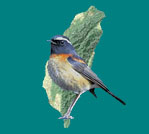|
TAIWAN BIRDS:
POSSIBLE FUTURE FULL SPECIES
As of October 2006,
Taiwan
has 15 endemic species and over 60 endemic subspecies. Some of
the endemic subspecies are sufficiently different from other
races to merit elevation to full species status. Comprehensive
studies have been undertaken for some; others have been
suggested as full species based on significant differences in
plumage, vocalization, habitat preference or breeding
morphology.
The
most likely next full species:
Taiwan
Hwamei Garrulax taewanus
References:
BirdingASIA
2: 34–52, “Subspecies of Taiwan birds—first impressions”, Nigel
J. Collar, 2004.
Forktail 22: 85–112, “A partial revision of
the Asian babblers (Timaliidae)”, Nigel J. Collar, 2006.
Ibis, Vol. 148, Issue 4, October
2006, page 698; “Species delimitation
in the Hwamei Garrulax canorus”, Shou-Hsien
Li, Jing-Wen Li, Lian-Xian Han, Cheng-Te Yao, Haitao Shi, Fu-Min
Lei and Chungwei Yen.
The
next most likely full species:
Taiwan
Barbet Megalaima nuchalis
References:
Abstracts,
One
Hundred and Twenty-second Stated Meeting of the
American Ornithologists' Union,
in conjunction with the
2004
Annual Meeting of the
Society of Canadian Ornithologists, Société des Ornithologistes
du Canada,
16 - 21 August
2004, “Molecular systematics and historical biogeography of the
Black-browed Barbet species complex
(Megalaima
oorti,
S. Muller 1835)”, Julie Feinstein,
Ambrose Monell Collection Molecular & Microbial Research,
American Museum of Natural History, New York, NY,
Xiaojun Yang,
Kunming Institute of Zoology, China Academy of Sciences,
Kunming, China,
and Shou-Hsien Li,
Department of Life Science, National Taiwan Normal University,
Taipei, Taiwan.
BirdingASIA
2: 34–52, “Subspecies of Taiwan birds—first impressions”, Nigel
J. Collar, 2004.
Forktail 22: 170–173, “A
taxonomic reappraisal of the Black-Browed Barbet Megalaima
oorti”, Nigel J. Collar, 2006.
Other possible full species:
Black-necklaced
Scimitar Babbler Pomatorhinus erythrocnemis
Rufous-crowned Laughingthrush Garrulax ruficeps
Rusty
Laughingthrush Garrulax poecilorhynchus
Taiwan
Fulvetta Alcippe formosana
Taiwan
Scimitar Babbler Pomatorhinus musicus
Taiwan Wren
Babbler Pnoepyga formosana
Reference:
Forktail 22:
85–112, “A partial revision of the Asian babblers (Timaliidae)”,
Nigel J. Collar, 2006. Includes
Taiwan
Hwamei Garrulax taewanus.
…and…
Brownish-flanked Bush Warbler Cettia fortipes robustipes
Chinese
Bamboo Partridge Bambusicola thoracicus sonorivox
Island
Thrush Turdus poliocephalus niveiceps
White-browed Shortwing Brachypteryx
montana
goodfellowi
Reference:
BirdingASIA 2: 34–52, “Subspecies of
Taiwan birds—first impressions”, Nigel J. Collar, 2004.
A
partial revision of the Asian babblers
|
電話:02-23586186
傳真:02-23586190
聯絡人:卓倩慧 |
『TIBA為國爭光—出國比賽得冠軍』
國際鳥盟全球研究計畫負責人Dr.
N. J. Collar
與一組鳥類分類學家,於近期內密集拜訪大英自然歷史博物館、美國自然歷史博物館、紐約、華盛頓特區、巴黎自然歷史博物館及Genoa自然歷史博物館,檢查了各類亞洲畫眉的標本,然後測量每一隻鳥不同的部位,比較牠們的大小、型態及顏色,用一個計數系統標準來分級,它的標準是巨大明顯差異部分得三分、中度差異兩分、小差異一分。所有的得分標準如果超過七分,那麼證據足夠將特有亞種提升為一個獨立的特有種,用這套標準台灣將有上述七種新的特有種產生。
慶幸的是特有生物研究中心以及國內的鳥類學者已同步在今年完成畫眉的基因研究,並被國際鳥類期刊審核通過正式為新的特有種,表示台灣的生態保育以及鳥類研究正逐步趕上國際水準。
台灣國際觀鳥協會(TIBA)理事長楊宗哲立委表示,以台灣這麼小的面積中,除了原來的十五種特有種外,若再加上這七個新的特有種,那麼對於吸引世界各國的鳥友來台灣從事賞鳥及生態旅遊有很大的誘因。觀鳥協會所設立的網站http://www.birdingintaiwan.com在短短一年內以黃文欣、郭耿光及廖本興等鳥類攝影家,所拍攝精美的特有種及特有亞種照片,吸引了超過一百四十五個國家的鳥友,點閱率更突破五百萬人次,成為全球最受歡迎的鳥類網站之一。協會並將Dr.
N. J. Collar的論文貼在網站上,讓全球的鳥人分享這個好消息。
台灣國際觀鳥協會在交通部(觀光局)、外交部、農委會(林務局南投林區管理處)及連江縣政府、馬祖野鳥協會、彰化縣野鳥協會、OLMPUS會長郭耿光先生、中國石油股份有限公司的協助下參加今年2006年全球最大的生態保育及旅遊特展:大英鳥展,在450個攤位來自五十六個國家的各國攤位競爭下,以台灣人的熱情勇奪國際組金牌獎,交通部蔡堆部長於95年9月14日下午兩點,在交通部觀光局旅遊服務中心(台北市敦化北路一段240號)頒發金牌獎狀予各贊助單位,感謝他們的全力支持。
FORKTAIL, Journal
of Asian Ornithology, No. 22, August 2006, pp. 85–112
A
partial revision of the Asian babblers (Timaliidae)
N.
J. Collar, BirdLife International, Wellbrook Court, Girton
Road, Cambridge, CB3 0NA
Dr.
Nigel Collar
visited seven major natural history museums in the UK, USA,
France, the Netherlands and Italy (Natural History Museum,
Tring, UK; American Museum of Natural History, New York;
National Museum of Natural History, Washington DC; Muséum
National d’Histoire Naturelle, Paris; Naturalis, Leiden;
Carnegie Museum of Natural History, Pittsburgh; and Museum of
Natural History, Genoa) to examine study skins of Asian
babblers. He measured the birds’ various body parts and
compared their size, shape and colors. Using a scoring system
developed by a team of ornithologists (including himself), he
graded differences between the birds. He assigned 3 points
for major differences, 2 points for medium differences, and 1
point for minor differences. All of the points had to equal
at least 7 (including at least some major or medium
differences) for a bird to be raised from subspecies status to
full species status.
Although the scoring method is “simplistic, crude
and arbitrary,” it is a consistent and useful evaluation
tool. Using this scoring method, 44 Asian subspecies qualify
for elevation to full species status. Under this scoring
system,
Taiwan would
gain 7 more endemic babbler species: Garralax ruficeps, G.
poecilorhynchus, G. taewanus, Pomatorhinus erythrocnemis, P.
musicus, Pnoepyga formosana and Alcippe formosana.
Bird names in the following table are according to Inskipp,
T., Lindsey, N. and Duckworth, W. (1996) An annotated
checklist of the birds of the Oriental region.
Sandy, U.K. :
Oriental Bird Club.
|
Proposed new species: |
DERIVED from: |
|
Rufous-crowned
Laughingthrush,
Garrulax ruficeps |
White-throated Laughingthrush,
Garrulax albogularis |
|
Rusty
Laughingthrush,
Garrulax poecilorhynchus |
Note:
This proposed species is currently treated with the
proposed Buffy Laughingthrush Garrulax berthemyi
as two (of 3) subspecies of G. poecilorhynchus.
The new
Taiwan
endemic would retain both the English and Latin names.
|
|
Taiwan
Hwamei,
Garrulax taewanus |
Chinese
Hwamei,
Garrulax canorus |
|
Black-necklaced
Scimitar Babbler,
Pomatorhinus erythrocnemis |
Spot-breasted Scimitar-Babbler,
Pomatorhinus
erythrocnemis.
The new
Taiwan
endemic would retain the Latin name. |
|
Taiwan
Scimitar Babbler,
Pomatorhinus musicus |
Streak-breasted Scimitar Babbler,
Pomatorhinus
ruficollis |
|
Taiwan
Wren Babbler,
Pnoepyga formosana |
Scaly-breasted Wren Babbler,
Pnoepyga
albiventer |
|
Taiwan
Fulvetta,
Alcippe formosana |
Streak-throated Fulvetta,
Alcippe
cinereiceps |
On
Taiwan,
Rufous-crowned Laughingthrush seems to be relatively
uncommon, or with very limited distribution. Taiwan Hwamei
is more common, but is at greater risk because of genetic
swamping from Chinese Hwamei, which is imported into
Taiwan
as a cagebird because of its song, and which escapes regularly.
Acknowledgement:
Thanks to Dr. Nigel J. Collar for comments on this condensation
of his article. Jo Ann
MacKenzie
FORKTAIL is
published twice yearly, January and June, by the Oriental Bird
Club, Bedford, UK,
www.orientalbirdclub.org .
|

